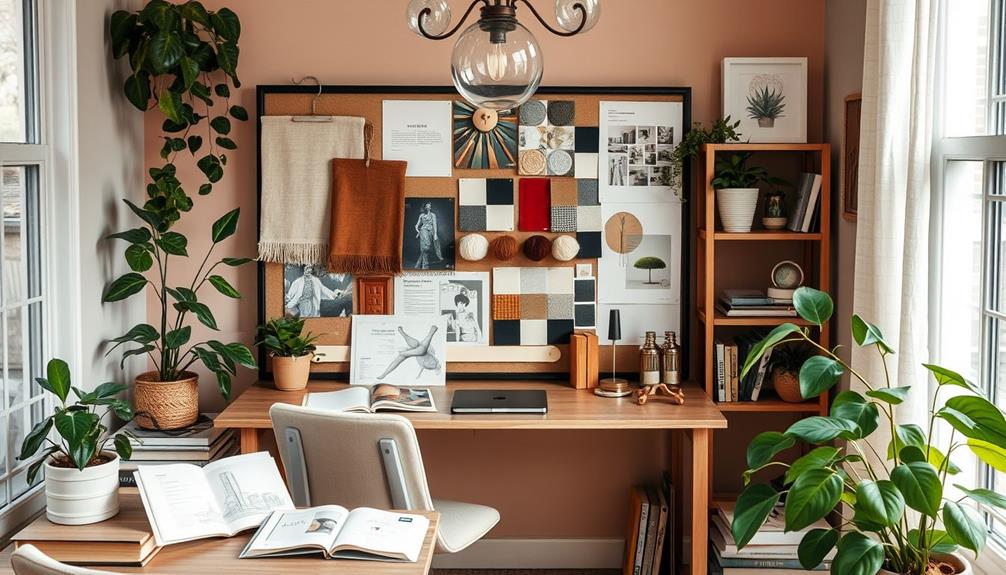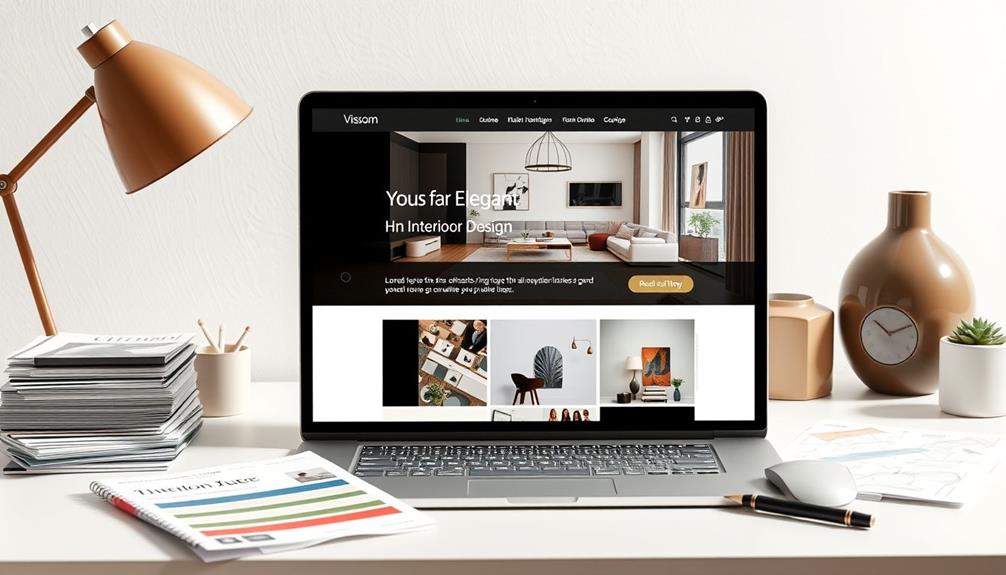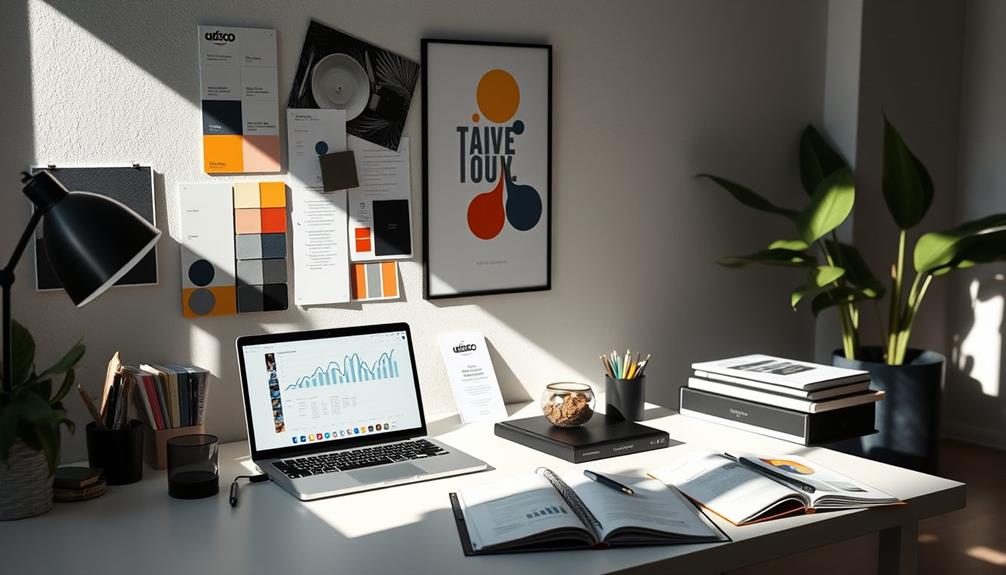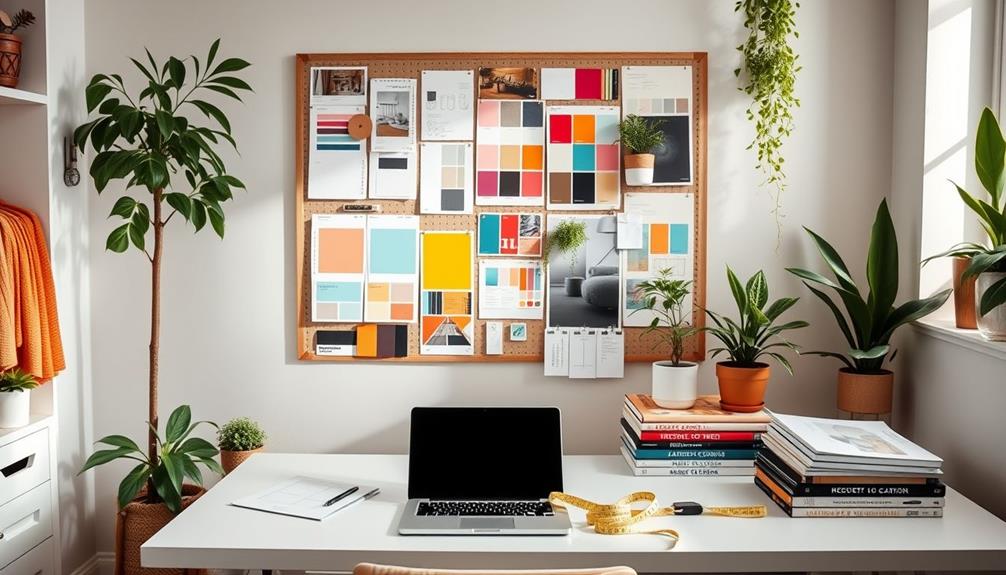To start your interior design business, first define your service offerings, which may include residential and commercial design, e-design, and consultations. Next, identify your unique style or niche, perhaps focusing on eco-friendly designs or specific demographics like young professionals. Once you've established your identity, register your business, ensuring you select an appropriate name and structure while adhering to local regulations. Create a professional website to showcase your portfolio, which should feature diverse designs and client testimonials. Finally, develop an effective marketing strategy leveraging social media and digital advertising to attract potential clients, guiding you toward further insights about successful approaches.
Key Takeaways
- Identify your unique design style and niche focus to differentiate your services in the competitive interior design market.
- Register your business by choosing a unique name, selecting a suitable business structure, and obtaining necessary licenses and permits.
- Develop a professional website with SEO optimization, showcasing your portfolio, services, and client testimonials to attract potential clients.
- Create an engaging portfolio that includes diverse design projects, high-quality images, and detailed descriptions to demonstrate your expertise.
- Implement a marketing strategy using social media, digital advertising, and networking to build an online presence and generate referrals.
Define Your Service Offerings

When launching your interior design business, it's crucial to define your service offerings clearly. By categorizing your services into distinct areas—such as residential design, including kitchens and baths; commercial design; e-design; and consultation services—you can effectively address diverse client needs. Each service should come with an associated list of deliverables, encompassing items like paint palettes, mood boards, 3D renderings, and furniture selections. This approach not only clarifies expectations for clients but also enhances their overall experience.
Additionally, integrating elements from comprehensive architectural solutions can elevate your service portfolio and attract a broader clientele.
Moreover, differentiating between full-service offerings, which incorporate project management, and e-design options allows you to cater to various budget levels and preferences, thereby broadening your market appeal. However, it's equally important to identify and clarify the limitations of your services upfront, outlining the scope of work and timelines to prevent overcommitment and guarantee client satisfaction.
Conducting thorough research on local demand and trends will further enable you to align your offerings with the specific needs of your target market. In steering this process, you'll find that a well-defined set of services not only streamlines your business operations but also fosters trust and clarity with your clients.
Establish Your Style and Niche

Establishing your style and niche is essential for standing out in the competitive interior design market. In the journey of launching your new interior design business, identifying a unique design style—be it mid-century modern, rustic, or minimalist—can greatly enhance your appeal to a specific target clientele.
Furthermore, concentrating on a particular niche, such as eco-friendly design or innovative small-space solutions, not only allows you to target a specific market segment but also positions you as an authority within that domain.
To effectively establish your style and niche, consider these key elements:
- Design Style: Define what aesthetic resonates with you and aligns with your skills.
- Target Clientele: Analyze the demographics of your ideal clients, whether families, young professionals, or commercial entities.
- Service Scope: Determine whether you want to focus primarily on residential projects, commercial spaces, or perhaps outdoor designs.
Register Your Business Name

After defining your design style and niche, it's time to register your business name. This vital step not only marks the official start of your interior design venture but also establishes your brand identity in a competitive marketplace.
Begin by choosing a unique business name that resonates with your services and carefully check its availability through your state's Secretary of State website, as conflicts with existing businesses can derail your plans.
When registering, consider the appropriate business entity—options like sole proprietorship, LLC, or corporation each come with distinct advantages. An LLC, for instance, often provides personal liability protection, safeguarding your personal assets from business-related risks.
Additionally, applying for an Employer Identification Number (EIN) through the IRS is fundamental, streamlining tax obligations while facilitating the hiring of employees or opening a business bank account.
Furthermore, verify compliance with local regulations by obtaining the necessary licenses or permits, as these can vary greatly from one municipality to another.
Keeping your documentation organized not only fosters credibility but also protects against potential legal challenges, thereby laying a solid foundation for your burgeoning interior design business.
Create a Professional Website

Creating a professional website is a pivotal step in establishing your interior design business, as it not only reflects your brand identity but also serves as an essential platform for showcasing your portfolio.
By selecting a memorable domain name, investing in an appealing visual design, and employing effective SEO optimization techniques, you can enhance your online presence and attract potential clients.
As you consider these elements, think critically about how each component contributes to your overall credibility and appeal in a competitive marketplace.
Domain Name Selection
Selecting the right domain name is a significant step for your interior design business, as it's often the first impression potential clients will have of you online. A well-chosen domain name not only enhances your online presence but also assists in SEO efforts, making it easier for potential clients to discover your interior design services.
Consider these three essential factors when selecting your domain name:
- Relevance and Memorability: Aim for a domain name that's short, memorable, and reflective of your design specialty, such as "moderninteriors.com" or "ecodesignsby[name].com."
- Uniqueness: Verify the domain name is unique by checking registration platforms like GoDaddy or Namecheap. This helps you avoid trademark conflicts that could hinder your business growth.
- Reliable Web Hosting: Choose a dependable web hosting provider that guarantees good uptime and customer support. This is important as your business expands, allowing for scalability in your online offerings.
Visual Design Elements
Crafting a professional website is essential for showcasing your interior design business and attracting clients. As you initiate this endeavor, consider how visual design elements can greatly impact your brand identity.
Start by registering a domain name that resonates with your design philosophy while securing reliable web hosting for a consistently accessible platform. Utilizing user-friendly platforms like WordPress or Squarespace allows you to create an aesthetically pleasing interface that engages visitors. Additionally, consider drawing inspiration from breathtaking destinations that reflect your unique style and vision.
High-quality images of your completed projects are important, as research indicates that nearly 75% of online consumers assess a company's credibility based on visual appeal. In starting an interior design business, integrating compelling visuals not only showcases your design skills but also strengthens your marketing plan.
Moreover, confirm that your website is mobile-responsive; with over 50% of web traffic originating from mobile devices, it's imperative to provide a seamless user experience.
SEO Optimization Techniques
A well-optimized website is essential for your interior design business to thrive in today's digital landscape. To enhance your SEO visibility and attract more web traffic, consider the following strategies:
- Choose a Memorable Domain: Select a domain name that reflects your interior design services while incorporating relevant keywords. This won't only boost your SEO visibility but also make it easier for potential clients to remember your site.
- Build a Mobile-Responsive Site: Utilize platforms like WordPress or Squarespace to create a mobile-responsive and user-friendly website. Given that over 50% of web traffic originates from mobile devices, this aspect is critical for retaining visitors.
- Incorporate High-Quality Images: Showcase your design work with high-quality images and utilize alt text with pertinent keywords. This practice optimizes your site for search engines while improving load times, ultimately enhancing user experience.
Additionally, maintain a blog section featuring design tips and trends; fresh content through content marketing is essential for improving SEO rankings.
Implement on-page SEO techniques, such as meta descriptions and internal linking, to further clarify your site's structure and relevance to search engines.
Build Your Portfolio

Your portfolio is the backbone of your interior design business, showcasing your unique style and expertise. To effectively build your portfolio, it's crucial to present a diverse array of drawings, including both 2D and 3D designs, which illustrate your ability to conceptualize and execute various room layouts and design elements.
By including a selection of design palettes that cater to different styles and preferences, you can demonstrate your versatility and understanding of color theory. Moreover, personal shopping recommendations that consider quality and budget will further showcase your expertise in sourcing materials and furnishings.
High-quality before-and-after photos of the spaces you've designed visually articulate the impact of your work and your capacity to create beautiful transformations. Additionally, incorporating client testimonials and detailed project descriptions not only builds credibility but also highlights the positive experiences of those you've worked with, reinforcing the types of services you offer.
As you develop your portfolio, remember that it should also align with your financial plan, ensuring that it reflects your design experience while attracting potential clients who resonate with your aesthetic and vision.
Develop a Marketing Strategy

Marketing is essential for launching and growing your interior design business. A well-crafted marketing strategy not only draws clients but also solidifies your brand in a competitive market. To effectively engage potential clients, consider the following components:
1. Create a Professional Online Presence: Invest in a visually appealing website that showcases your portfolio, services you'll offer, and client testimonials. Allocate around $250 per year for hosting and domain registration to guarantee reliability.
Implementing keyword clustering can enhance your website's SEO and improve discoverability.
2. Leverage Social Media: Platforms like Instagram and Pinterest are ideal for visual marketing in the interior design industry. Regularly post engaging content that reflects your clear vision and aesthetic, allowing potential clients to connect with your work.
Additionally, engaging with your audience through comments and social media can build a community around your brand.
3. Network Actively: Attend local networking events and industry trade shows to build relationships with real estate agents and contractors. These connections can lead to referrals and collaborative opportunities.
Moreover, implementing search engine optimization (SEO) strategies, including targeted blog posts, enhances your website's visibility, attracting organic traffic.
Consider incorporating digital marketing techniques, such as Google Ads, to reach specific demographics and elevate your brand's presence among potential clients.
Frequently Asked Questions
How to Begin Your Own Interior Design Business?
To begin your own interior design business, define your target market, create a solid business plan, register your business, build a professional website, and develop a marketing strategy to attract clients effectively. When defining your target market, consider what types of clients you want to work with and the specific services you want to offer. Once you have a clear understanding of your target market, create a business plan that outlines your goals, financial projections, and marketing strategies. Register your business and obtain any necessary licenses or certifications to ensure you are operating legally. Building a professional website that showcases your work and services is crucial for attracting and retaining clients. Lastly, when developing a marketing strategy, consider utilizing social media, networking events, and referrals to build a strong client base. Tips for interior design consulting may include creating mood boards, offering virtual design services, and staying updated on the latest design trends.
Is Interior Design Business Profitable?
Is interior design profitable? Absolutely! While profit margins can vary, many designers enjoy solid earnings. With 71% reporting positive outlooks, the industry's growth and demand make it an exciting venture worth pursuing. You're in the right place!
How to Start an Interior Design Business With No Experience?
To start your interior design journey without experience, educate yourself through online resources, build a portfolio with personal projects, network with professionals, and leverage social media to showcase your work and attract clients.
How Do I Start a Freelance Interior Design?
"Where there's a will, there's a way." To start your freelance interior design journey, identify your niche, create a portfolio, register your business, set competitive pricing, and market yourself effectively online to attract clients.
Conclusion
In starting your interior design business journey, envision your aspirations as a tapestry, intricately woven with threads of creativity, strategy, and professional integrity. By defining your service offerings, establishing a distinctive style, and creating a robust portfolio, you're not merely launching a business; you're crafting a narrative that resonates with potential clients. As you navigate the complexities of marketing and branding, remain attuned to the evolving landscape of design, allowing your unique vision to illuminate the spaces you transform.









